As we gathered in the Fairbanks offices of the Northern Alaska Tour Company – 17 half-awake people in the dim summer light at 4:30 a.m. – there was a palpable sense of excitement.
My wife and I were carrying layers of polar clothing (at least, as “polar” as you can find in Florida!). And so were the sleepy collection of 15 other Americans, Aussies, and New Zealanders gathered around the coffee machine in an effort to wake up.
I was about to check an item off my “bucket list.” Even as a young child, I had devoured everything I could read about the exploits of the Arctic explorers. And now, I was about to become one.
Our destination is the Arctic Circle. Or, to be precise, a fuel-stop/bar/trading-post/general-store at a junction called Coldfoot (pop. 10), about 70 miles north of the Arctic Circle. And we’ll be going there by bus, and returning to Fairbanks by bush plane.
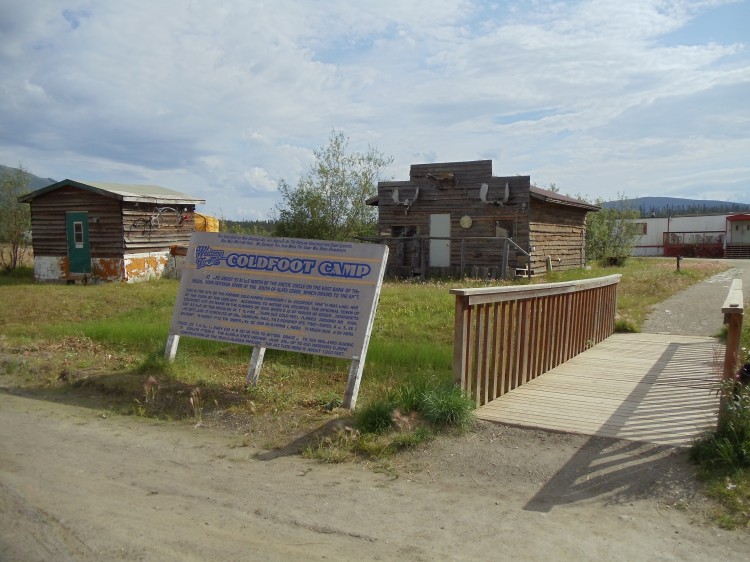
As our 17 polar explorers boarded the bus, my wife and I tossed our polar layers across two empty seats, piled our food on top of them, and made ourselves comfortable for the ten-hour ride.
If you’ve ever seen the History Channel series called “Ice Road Truckers,” you know the road. It’s the Dalton Highway, threading the thousand miles from Anchorage to the North Slope oil fields, through hundreds of thousands of square-miles of Arctic tundra and jagged peaks. It’s driven every day by some of the toughest men and women in the world, who brave 20-foot snow drifts, 100-below-zero temperatures, and white-out blizzards in winter, and, in summer, a winding, rocky road on which the only signs of human life are occasional roadside outhouses painted with funny messages and three ramshackle, colorful trading posts where you can get hot coffee, food, and some additional “polar” wear if you need it.
When the pavement ends just north of Fairbanks, so does the auto traffic. For the next nine hours, we’ll be riding on a sort of home-made road. And the only vehicles we’ll see will be the occasional oil tankers speeding by us in their rush to get back to the North Slope to pick up another load.
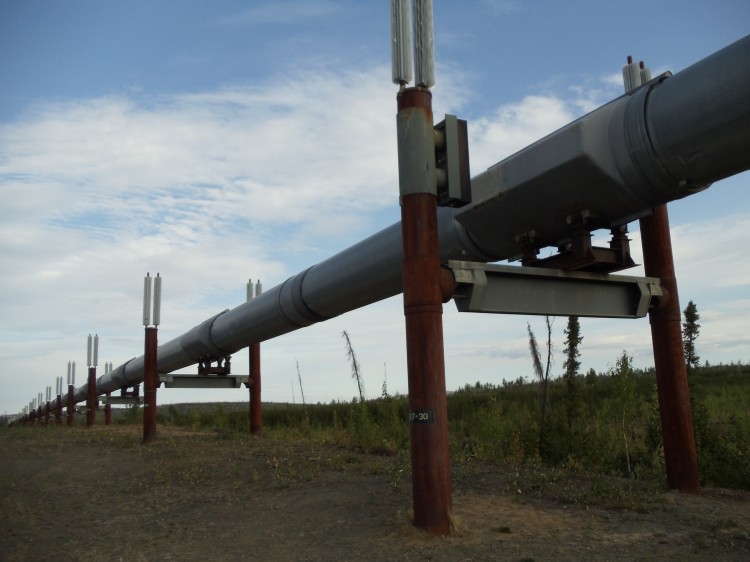
It doesn’t take long after leaving Fairbanks before you come upon the Alaska oil pipeline. We’ll drive alongside of it pretty much the rest of the trip. It runs 5-10 feet off the ground, looping over an Arctic quilt of ice-blue rivers, grassy mountains, forests, and mud flats. After a while, the driver stops the bus, and we go outside to touch the pipeline and take some photos.
Every hour or two we stop at one of the isolated trading posts to pick up coffee or use a bathroom (or one of those colorful outhouses if there’s no bathroom).
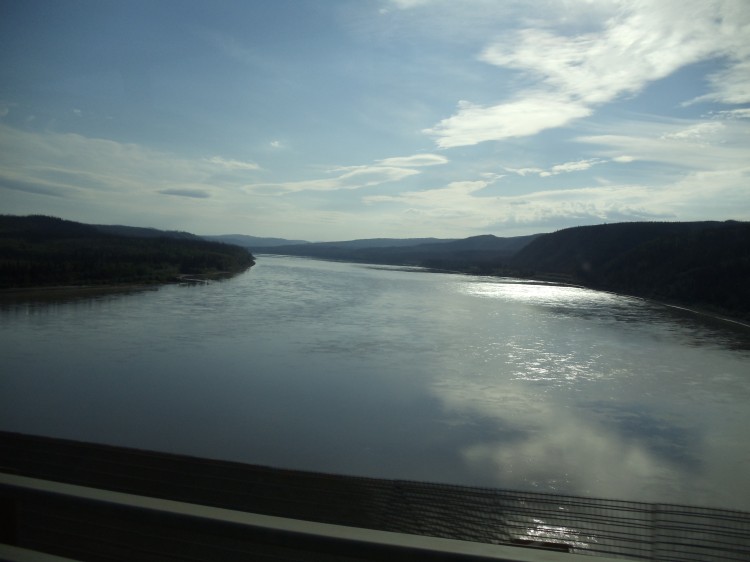
As the hours go by, the landscape changes from tall, green mountains and rolling woodlands to shorter, rockier mountains with fewer trees and grass; more rolling, open land; and small trees that look like their growth has been stunted. We cross the bridge over the mighty Yukon River, which is bordered by huge gray mud flats. Our guide/driver notes that there are a few Native villages in the interior, but no roads to get there (which is why bush planes and pilots are the lifelines of these villages.)
As the hours pass, the anticipation of reaching the Arctic builds. Then, finally, we arrive at the marker for the Arctic Circle!
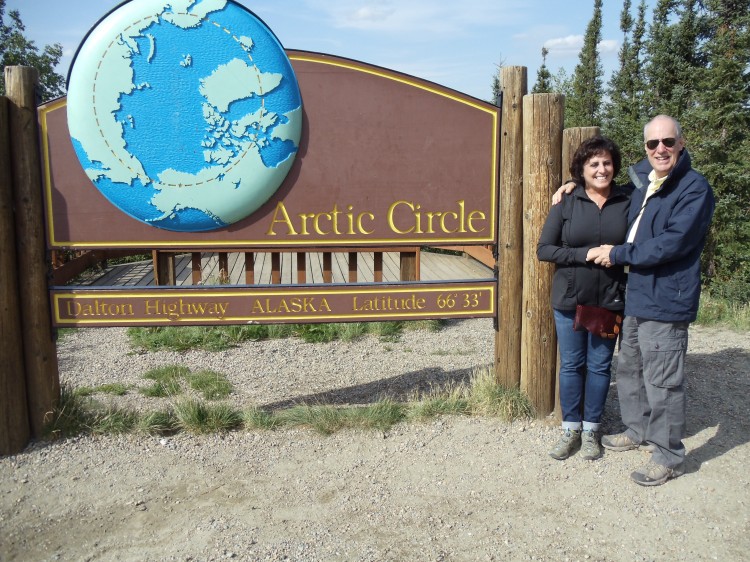
We get off the bus and it’s surprisingly warm. We take the obligatory photos at the marker, of course, and then several of us chat with the older couple who volunteer for the Department of the Interior. It occurs to me that we’re probably the only people they’ve seen all day.
As we continue north, a shout alerts everyone on the bus – there are two bears to our left! Then we see another one a while later, this time on the right. And later on, yet another excited shout; a lone wolf is watching us intently from a rocky promontory looming over the road to our right.
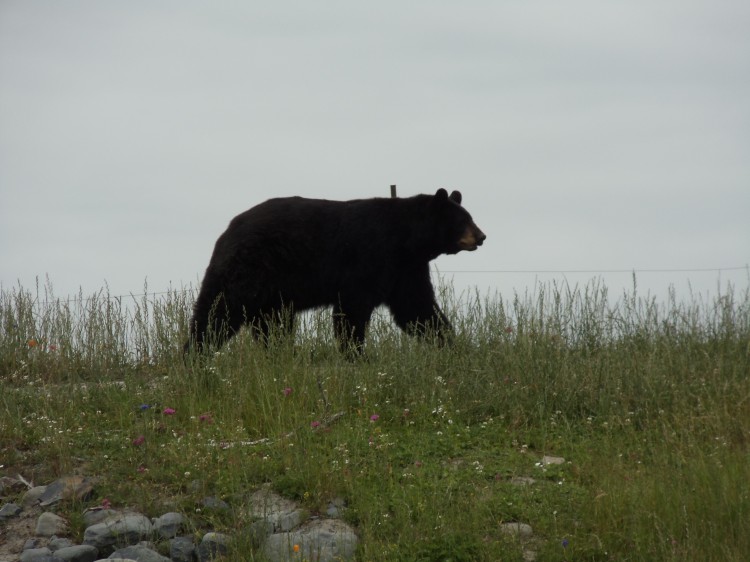
An hour later we stop again, this time to explore some stark granite outcroppings emerging from the tundra and the permafrost, the permanent layer of ice only a foot beneath the surface in Alaska. As we clamber over the dramatic rock formations, we’re attacked by hordes of mosquitoes intent on making us their lunch.
Standing here, you may as well be on the moon. Nothing really grows here. The bushes and small trees are gone. The tundra is covered by isolated tufts of short, emaciated grass. The jagged, rocky mountains are bare.
Other than the buzz of the mosquitoes, there’s no sound either. This land seems to flow on without end in the loudest silence I’ve ever heard.
An hour later, we arrive at Coldfoot and step out of the bus – into a balmy 70 degrees! And off comes the rest of whatever polar wear we still had on.
We’re in the middle of the enormous Brooks Range now, with brownish-green mountains surrounding this tiny “settlement” of a few trailers and wooden homes, home to the “Pop. 10” who man the gas pump and the beer tap and the general store.
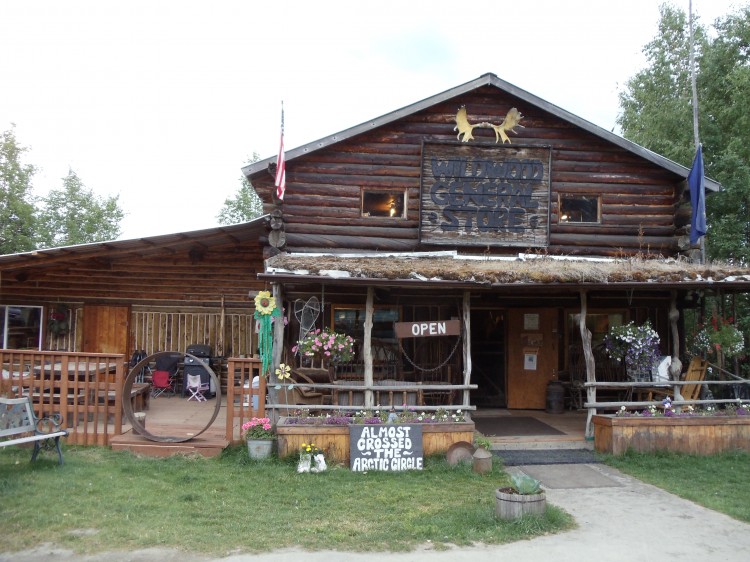
Before we get back on the bus for the short trip to the airplane strip, I stand alone for 15-20 minutes, taking in the vastness and emptiness of this place. And I’m shocked by the absence of something I had expected to see a lot of – snow! There is none. Nor is there any ice. None. Yes, it’s August, but even in August the rest of Alaska is filled with snow-capped mountains and ice fields and glaciers. But not the Arctic. “The Great White North” upon which I’m gazing is definitely “great”, but it sure ain’t white!
The Arctic – at least in August – is nothing like I had imagined. A few months from now, temperatures here will approach 100-below. The drifts from whipped snow will be as high as the lone building and the two trailers, and the tanker drivers who stop here for a warm coffee will have just experienced dangers the rest of us can’t even imagine. But not in August!
Soon, we’re winging back toward Fairbanks in a 9-seat Piper Chieftain aircraft, operated by a bush pilot who normally flies supplies to isolated Native villages. We have to wear headphones, otherwise the noise from the engines – only a couple of feet away – would be too much for us. You almost have to shout to be heard by the person in the single-seat across the (very narrow!) aisle. We bob and weave in between huge mountains – with plenty of snow on them – and over winding silver rivers. And we can even look down and see a couple of those isolated Native villages sitting on the banks of rivers which provide a large part of the local diet.
After 80 minutes – as opposed to the ten-hour bus trip that took us to the Arctic Circle – we can see the distant gleam of Fairbanks’ buildings up ahead, and soon we’re touching down at the airfield.
As we do, I realize that it’s going to take a long time to process what I saw and experienced on this day. But I’ve crossed off an item I’ve had on my Bucket List since long before any of us had ever heard the term “Bucket List”!
WHERE TO STAY IN FAIRBANKS:
One of Fairbanks’ best resorts is actually 60 miles from town. Surrounded by glaciated peaks and dramatic vistas, the Chena Hot Springs Resort is a 100-year-old Alaska lodge built around the world’s greatest outdoor steam-rooms – the hot springs on which it sits. The hotel has 80 authentically-furnished rooms, and a genuine ice museum (yes, it’s actually made of ice!). And in autumn and early-spring, the views of the Northern Lights dancing across the sky are spectacular. Back in town, the Fairbanks Princess Riverside Lodge (325 guestrooms) is on the Chena River, close to downtown attractions and restaurants. The Wedgewood Resort has 306 guestrooms, and is adjacent to the Fountainhead Antique Auto Museum, which has an impressive collection of vintage automobiles and antique wardrobes.
RESOURCES:
Fairbanks Convention & Visitors Bureau – www.explorefairbanks.com
Northern Alaska Tour Company – www.northernalaska.com
Chena Hot Springs Resort – www.chenahotsprings.com
Fairbanks Princess Riverside Lodge – www.princesslodges.com
Wedgewood Resort – www.fountainheadresorts.com
Fountainhead Antique Auto Museum – www.fountainheadmuseum.com

